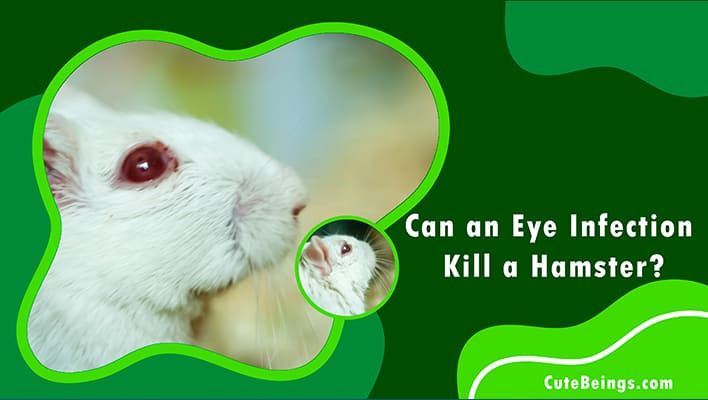As a hamster owner, I am often asked if an eye infection can kill a hamster. In this article, we will explore the dangers of infections to these small rodents and investigate whether it is possible for an eye infection to be fatal in hamsters.
Eye infections occur when pathogens such as bacteria or fungi invade the eyes and cause irritation or inflammation. This can lead to pain, redness, swelling, discharge from the eyes and changes in vision. If left untreated, eye infections can spread further into the body and become more serious or even life-threatening.
Infections in hamsters can quickly become severe due to their small size; therefore early diagnosis and prompt treatment by a veterinarian are essential for preventing complications and long-term damage. So let’s take a closer look at how an eye infection can affect your pet’s health and find out if it really could be deadly!
Table of Contents
So, Can An Eye Infection Kill A Hamster?
So, can an eye infection kill a hamster? The answer is a resounding yes. Like any other living creature,hamsters are vulnerable to illness and disease; an eye infection can be particularly devastating for these small mammals. In some cases, the bacteria will cause severe inflammation of the eyes leading to blindness or even death if not treated quickly and appropriately.
It is important for pet owners to recognize the signs of an eye infection in their beloved hamsters and seek medical advice as soon as possible. By identifying the problem early on, it may be possible to drastically reduce suffering – both physical and emotional – and save the life of your precious hamster.
What Causes Eye Infection In Hamsters?
Eye infection in hamsters is typically caused by bacteria or parasites that have entered the eye. It can also be caused by a virus, although this is rarer than with other rodents. The most common causes of eye infections in hamsters include:
- Bacterial infections- Bacteria such as Staphylococcus and Pseudomonas are commonly found in hamster eyes and cause conjunctivitis and keratoconjunctivitis when they become too numerous.
- Fungal infections- Common fungal organisms like Aspergillus, Candida, and Cryptococcosis may enter a hamster’s eye and lead to inflammation and discharge.
- Parasitic infestations- Hamsters are prone to parasitic infestations from mites and fleas which can transmit disease into the eye leading to irritation and discomfort.
- Trauma or foreign bodies- Injuries from fighting or environmental hazards such as dust particles, dirt, grasses or straws blown into the eyes can lead to infection if not treated promptly.
The risk of developing an eye infection increases in certain conditions, including overcrowding, poor hygiene, inadequate nutrition, high temperatures, high stress levels, and exposure to sunlight. To prevent any potential risks, it’s important for owners to ensure their pets is living in clean environments free of debris, dust and allergens while maintaining optimal temperature conditions within their home. Additionally, providing fresh food sources rich in vitamins A & C will help keep your furry friend healthy overall–including the eyes!
Hamster Eye Infection Symptoms
The signs of an eye infection in a hamster can be as subtle as the quiet rustle of dried leaves, or as obvious as a firework display. It is important for anyone owning a pet hamster to be aware of the symptoms associated with an eye infection so that they can take appropriate action and seek out medical advice if necessary.
Common symptoms include redness or swelling in one or both eyes, discharge from either eye (clear, yellowish-green, or bloody), excessive squinting or blinking, rubbing at the eyes, crustiness around the edges of either eyelid, and discoloration of the fur near the infected area. In more severe cases, blindness may occur due to inflammation of structures inside the eye. If left untreated it can result in permanent damage or even death in extreme circumstances.
Read also : Does your hamster have a bleeding eye?
What Does A Hamster’s Eye Infection Look Like?
A hamster’s eye infection is often identified by signs such as redness, swelling, and a discharge that can be either clear or cloudy. Other symptoms include excessive squinting, scratching of the eyes, and visible discomfort when light shines directly into their eyes. In severe cases, an ulcer may form on the cornea which could lead to vision loss. To diagnose an eye infection in your hamster accurately, it’s important to take them to a vet for further examination.
Treatment of a hamster’s eye infection will depend on its severity and cause but typically involves topical antibiotics or anti-inflammatory medications to reduce inflammation and protect against secondary infections. If the underlying cause is not treated properly then recurrence is likely. It’s also important to keep your pet’s environment clean and free from debris that could irritate their eyes further. By being vigilant with hygiene practices you can prevent any potential flare ups of your pet’s eye infection in the future.
If you suspect that your hamster has an eye infection, it is essential to seek veterinary advice as soon as possible so they can provide appropriate treatment plan tailored specifically for your pet. This way you can ensure that your furry friend remains healthy and happy going forward!
What Do You Do If Your Hamster Has An Eye Infection?
Treating an eye infection in a pet hamster is like attempting to contain a wildfire – you must act swiftly and decisively. If your hamster has been suffering from redness, swelling, or discharge around the eyes for any longer than two days, it’s important to take them to the vet right away. Your veterinarian will likely prescribe ointment and/or oral medication to treat the infection.
In cases where visiting the vet isn’t possible, treating your hamster’s eye infection at home can be done with over-the-counter antibiotic creams as long as they are safe and approved for use on small animals. You should also keep their cage clean of debris that could further irritate the infected area and give them extra bedding or nesting material so they don’t scratch at their face too often. Additionally, providing your furry friend with vitamin supplements may help improve its overall health — boosting immunity and helping fight off infections more effectively.
With proper treatment, most hamsters make a full recovery from eye infections within one to three weeks’ time. However, if left untreated, these infections can lead to serious complications such as blindness or even death in extreme cases. It is therefore essential that owners check their pets regularly for signs of illness and seek professional medical advice if needed.
How To Treat A Hamster Infection At Home
Treating a hamster infection at home is possible; however, it should be done with caution. It is important to ensure the proper diagnosis and treatment of any potential infections that your hamster may have before attempting to treat them yourself. Here are some steps you can take when treating an eye infection in a hamster:
- Have a vet check for bacterial or viral infections.
- Keep the cage clean and disinfected regularly.
- Provide fresh water and food daily.
- Administer antibiotics or other medications as prescribed by the veterinarian.
It is also essential to monitor the progress of your hamster’s health during treatment and make sure they get plenty of rest and exercise. If these treatments do not provide relief from symptoms after a few days, it is recommended to seek professional medical advice from a qualified veterinary surgeon immediately. By following these guidelines, you will ensure that your pet receives the best care possible while keeping their comfort and welfare in mind.
Can Hamster Eye Infections Heal On Their Own?
Studies have shown that the majority of hamster eye infections can heal on their own without medical intervention. In fact, approximately 80% of infections will resolve within two weeks with proper care and sanitation. As such, it is important to provide a clean environment for your pet with regular cage cleaning and fresh bedding material. Additionally, keep an eye out for signs of infection in your hamster’s eyes as early detection may lead to quicker resolution.
The most common symptoms of eye infections in hamsters are redness or swelling around the eyes, excessive tearing, discharge from the eyes and squinting due to discomfort or pain. If any of these signs appear, immediate veterinary attention should be sought as antibiotics may be necessary for more severe cases. While most mild cases can be treated at home by keeping surfaces clean and providing ample rest and nutrition, failure to seek professional help when needed could result in permanent vision loss or even death if left untreated long enough. Therefore, being proactive about observing changes in your pet’s health is essential for its well-being.
It is also worth noting that some bacterial infections require topical ointments which can only be prescribed by a veterinarian; thus seeking professional advice sooner rather than later can save time and money while helping ensure optimal recovery outcome. With appropriate treatment, most hamster eye infections should improve significantly within 3-5 days but full healing may take up to 2 weeks depending on the severity of the condition. Understanding how long it takes for an infection to get better helps determine whether additional treatments are necessary or not so timely diagnosis is key when dealing with potential eye problems in small animals like hamsters.
How Long Does A Hamster’S Eye Infection Take To Get Better?
Hamsters with eye infections can recover in a short amount of time if the infection is treated promptly. The healing process for hamster eye infections will vary depending on the severity of the infection and how early it was caught and treated. Typically, this recovery period includes the following:
- A course of antibiotics to treat bacterial conjunctivitis
- Application of topical ointments to reduce swelling and discomfort
- Regular cleaning and flushing of the eyes with saline solution
If left untreated or improperly managed, an eye infection can become life-threatening or cause permanent damage to a hamster’s sight. Therefore, it is important to seek veterinary care as soon as possible when your hamster exhibits signs of an eye infection. With prompt diagnosis and proper treatment, most hamsters can make a full recovery within two weeks without any long-term effects on their vision or lifespan.
The success rate for treating a hamster’s eye infection depends on several factors, including species, age, overall health condition, and environmental stressors such as overcrowding or exposure to other animals carrying disease organisms that could be spread from one animal to another through contact with saliva, urine, feces, fur etc..
By understanding these variables and knowing what type of preventive measures are necessary for maintaining good sanitation practices among pet rodents like hamsters, we can help ensure their optimal well being. Ultimately, providing adequate medical care at the first sign of an eye infection is essential in order to give your beloved companion the best chance at recovering quickly and completely from any potential illness they may face throughout their lifetime.
How Long Can A Hamster Live With An Eye Infection
The life expectancy of a hamster with an eye infection depends on the severity of the condition and how quickly it is diagnosed. If left untreated, serious damage can be caused to their eyes which can lead to vision impairment or even blindness. It is important that any hamster showing signs of an eye infection should be taken to a veterinarian as soon as possible in order for them to receive proper treatment.
In some cases, if the infection is treated promptly, the prognosis may be good and the hamster’s vision could potentially return back to normal. However, if not attended to early enough then there is a high chance that permanent damage will occur and the hamster may lose its sight permanently. In severe cases, this can have fatal consequences due to complications such as secondary infections or dehydration.
Therefore, it’s imperative that owners take care of their pet’s health by regularly checking for signs of illness and taking them for regular check-ups at the vet clinic. Early diagnosis greatly improves the chances of successful treatment and increases the life expectancy of your pet hamster.
Conclusion
In conclusion, an eye infection can be fatal to a hamster if left untreated. Hamsters are prone to developing eye infections due to the fact that their eyes are so close together and they may develop conjunctivitis or other bacterial infections. It is important for owners to recognize the signs of an eye infection in their pet as soon as possible to ensure proper treatment and prevent potential death.
My research has shown that early detection of symptoms such as redness around the eyes, discharge from one or both eyes and excessive scratching of the face area can help catch an infection before it progresses too far. Treatment typically involves antibiotics prescribed by a veterinarian, although some home remedies may also be effective under certain circumstances.
Finally, I want to emphasize how important it is for any owner to seek professional medical attention if they suspect their hamster has an eye infection – even relatively minor ones should not be taken lightly! With prompt intervention, you can help your pet get back on track with minimal complications and potentially save its life in the process.

Hello, my name is James and I’ve been caring for tiny pets for over 14 years with a passion. I enjoy passing on my expertise to other individuals in order for them to have the same amount of enjoyment as I do.




